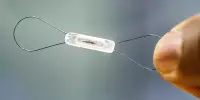Nanoparticles have received a lot of attention in the field of cancer therapy because of their unique properties that can be used to optimize drug delivery and treatment.
Pancreatic cancer is one of the deadliest types of cancer in humans. It is the fourth leading cause of cancer-related deaths in the Western world. Because the disease often progresses without symptoms in the early stages, diagnosis is typically delayed. Another issue is that advanced tumors – and their metastases – cannot be completely removed. Chemotherapies, in turn, attack not only tumor cells but also healthy cells throughout the body.
Innovative nanoparticles could be a new approach to more precisely treating cancer. A research team from the Max Planck Institute (MPI) for Multidisciplinary Sciences, the University Medical Center Göttingen (UMG), and the Karlsruhe Institute of Technology (KIT) created the approach. The therapy is now being optimized for clinical use as soon as possible.
The method promises to treat pancreatic cancer with greater precision and fewer side effects than current cancer treatments. They used nanoparticles to deliver large amounts of the active substance Gemcitabine directly into the tumor.
Using nanoparticles to target the drug in high concentrations into tumor cells improves efficacy while sparing healthy cells. This has the potential to reduce the severe side effects associated with Gemcitabine.
Myrto Ischyropoulou
“Using nanoparticles to target the drug in high concentrations into tumor cells improves efficacy while sparing healthy cells. This has the potential to reduce the severe side effects associated with Gemcitabine,” explains Myrto Ischyropoulou, lead author of the study published recently in the journal Advanced Materials.
“At the moment, patients receive the free drug. This is distributed throughout the body and has the potential to cause toxic effects in all areas. The nanoparticles, on the other hand, primarily deliver the drug to the tumor. Using imaging methods, we have already been able to demonstrate in mouse models that the nanoparticles accumulate in the tumors,” says Joanna Napp, a scientist at the UMG and the MPI.

Nanoparticles can be designed to carry and deliver anticancer drugs directly to the tumor site while causing as little damage as possible to healthy surrounding tissues. Surface modifications of nanoparticles can enable specific targeting of cancer cells via ligands that recognize and bind to cancer cell surface receptors overexpressed.
Nanoparticle administration also allows tumor resistance mechanisms to be bypassed. “Free Gemcitabine is frequently no longer taken up by the tumor very early on, rendering it largely ineffective. However, it still causes significant side effects, such as in the liver and kidneys,” explains Claus Feldmann of KIT. “By using a different uptake mechanism in tumor cells, our nanoparticles could be a very effective new therapeutic approach here.”
According to Frauke Alves, group leader at the MPI and the UMG, the research success is an excellent example of successful interdisciplinary collaboration. “From the idea to the development of the new nanoparticles to preclinical testing, chemists, biologists, pharmacists, and physicians have worked hand in hand.” The scientists are now working on a spin-off to get their new nanoparticles out of the testing phase and into clinical use as soon as possible.
















